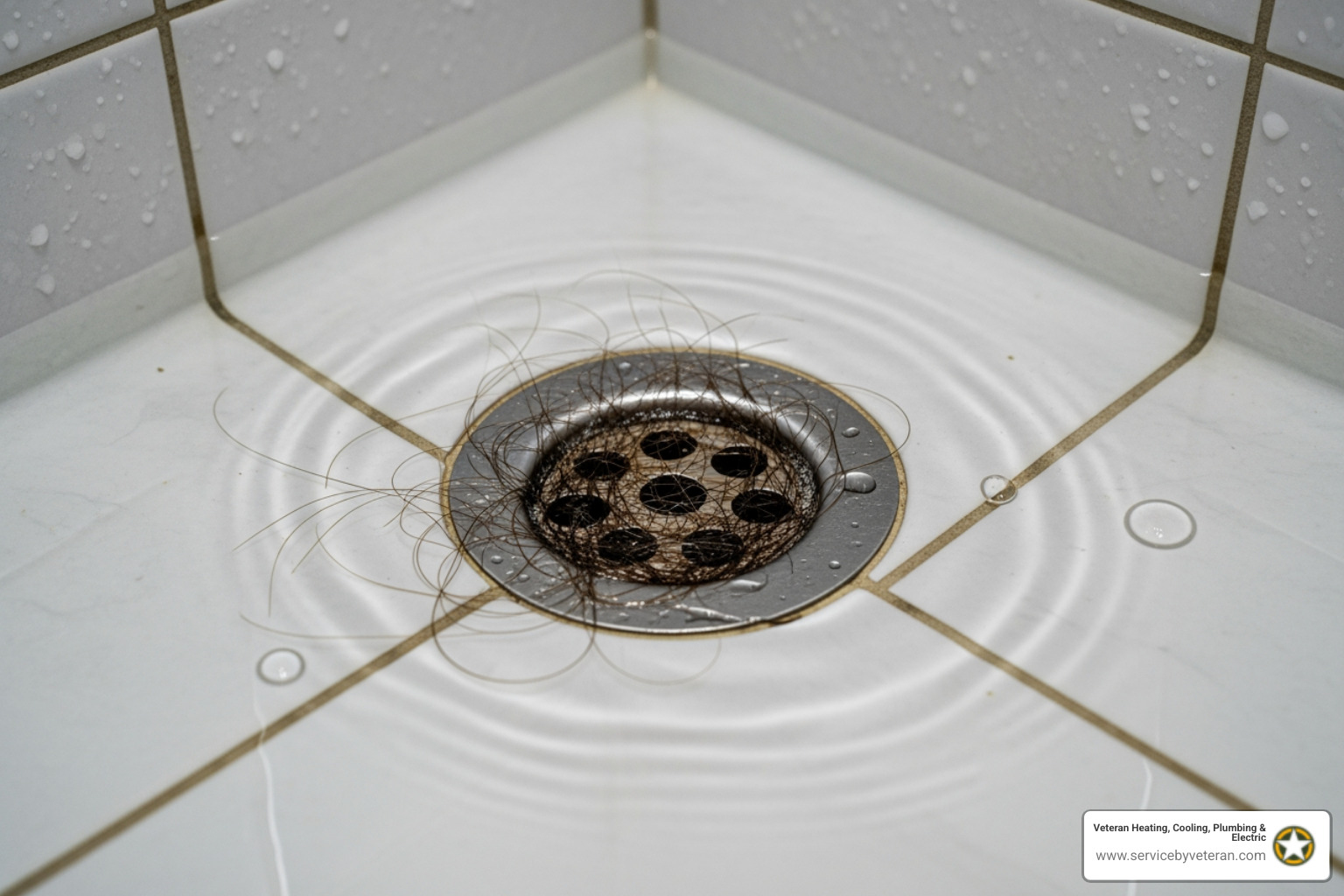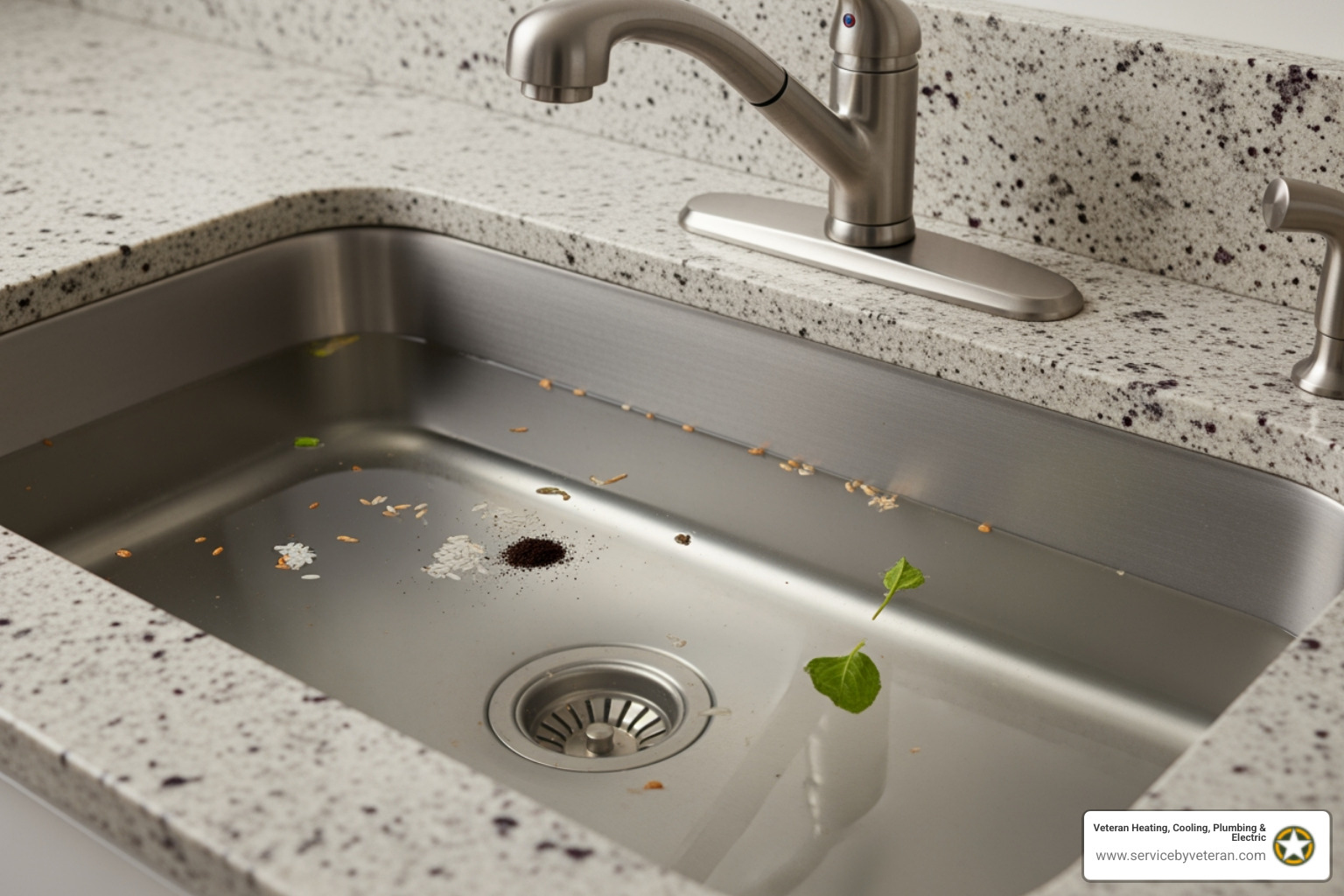Why Fast Action on Pipe Leaks Saves Your Home
Pipe repair becomes urgent the moment you spot a leak. A leaking pipe can damage floors, walls, and ceilings in hours and create the perfect environment for mold growth within 24 to 48 hours.
Quick Answer: Best Pipe Repair Solutions by Problem Type
| Problem | Best Temporary Solution | Best For |
|---|---|---|
| Pinhole leak or small crack | Pipe clamp or epoxy putty | Metal and plastic pipes |
| Leaking joint | Self-fusing silicone tape | Low-pressure lines, quick fixes |
| Larger crack (1" or more) | Pipe repair kit with resin wrap | Structural support needed |
| Burst pipe or hidden leak | Call a professional plumber | Permanent repair required |
Immediate steps when you find a leak:
- Shut off the water at the fixture valve or main supply.
- Drain the line by opening faucets below the leak.
- Assess the damage and choose the right temporary fix.
- Call a professional for permanent repair.
Temporary pipe repair products like clamps, epoxy putty, and self-fusing tape can stop a leak quickly, buying you time until a licensed plumber can make permanent repairs. However, they are not designed to last and should be replaced with proper plumbing work as soon as possible.
I'm Mike Townsend. My background includes eight years in the U.S. Army managing precision cooling systems. At Veteran Heating, Cooling, Plumbing & Electric, we've seen every type of pipe repair scenario, and we're here to help you understand which solutions work and when to call in the pros.

First Steps: What to Do When You Find a Leak
When you spot a leak, stay calm and act quickly to protect your home from serious damage.
Shutting off the water supply is your first move. For a leak under a sink or toilet, find the small oval or round fixture shutoff valve on the water line and turn it clockwise. If you can't find it, or the leak is in a wall or ceiling, shut off your home's main water valve. It's usually where the water line enters your house, such as a basement, crawl space, or near the water meter.
Once the water is off, drain the pipe by opening faucets at the lowest points in your home, like a basement sink or outdoor spigot. This releases pressure and clears the line for your pipe repair.
Safety is critical, especially regarding electrical hazards. If water is near outlets, fixtures, or appliances, shut off power to that area at your electrical panel immediately. Water conducts electricity, creating a serious danger. Never touch electrical equipment with wet hands or stand in water while handling anything electrical.
Next, contain the water and assess the damage. Use towels and buckets to manage drips and a wet/dry vacuum for standing water. The faster you remove water, the better your chances of avoiding floor damage and mold. Then, examine the leak. Is it a pinhole, a crack, or a dripping joint? Knowing the problem helps you choose a temporary fix or decide to call a professional. Our Plumbing Repair Lakewood Ultimate Guide offers more detail on common scenarios.
By following these steps—shutting off water, draining the line, ensuring safety, and containing the mess—you create a stable situation to decide on your next move.
Identifying Your Pipe and the Problem
Before attempting a repair, you need to identify your pipe material and the likely cause of the leak.
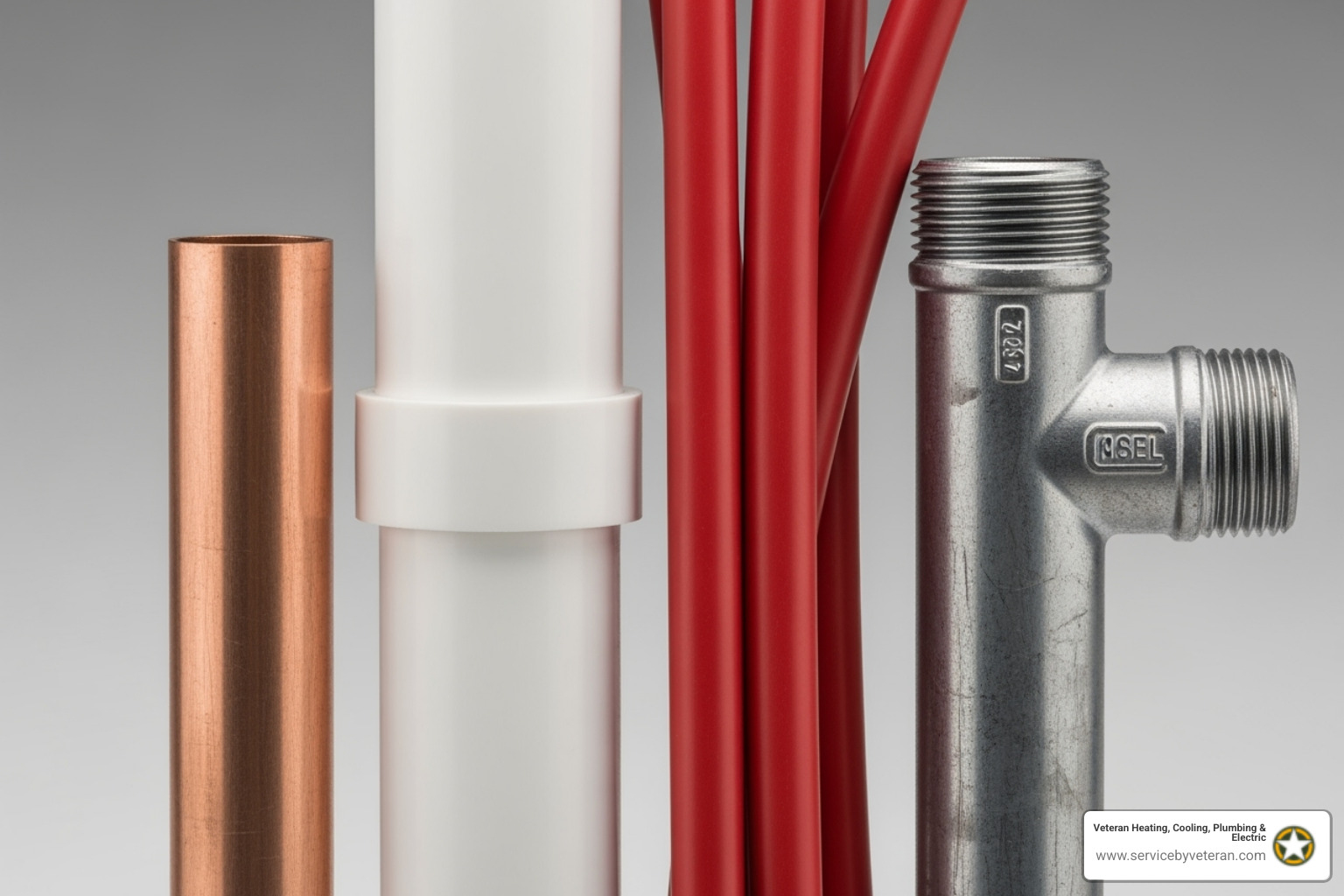
Common Pipe Materials:
- Copper pipes: Reddish-brown metal pipes common in older homes for water supply lines. They can develop pinhole leaks from corrosion over time.
- PVC pipes: Rigid white plastic pipes used for drains, waste systems, and cold water lines. They can become brittle and crack with age or impact.
- CPVC pipes: Off-white or yellowish plastic pipes, tougher than PVC and used for both hot and cold water supply.
- PEX pipes: Flexible plastic tubing, often color-coded (red for hot, blue for cold), popular in modern homes. Leaks almost always occur at the connections or fittings.
- Galvanized steel pipes: Heavy, silver-gray metal pipes with threaded connections, found in homes built before the 1960s. They are prone to internal corrosion and often require full replacement.
- ABS pipes: Rigid black plastic pipes used for drain and waste systems, similar to PVC but more common in older homes.
Common Causes of Leaks:
- Corrosion: The slow breakdown of metal pipes due to chemical reactions, leading to pinholes and ruptures.
- High water pressure: Excessive pressure strains pipes and fittings, causing leaks at weak points. A failed pressure regulator is a common culprit.
- Frozen pipes: Water expands when it freezes, which can burst pipes in unheated areas like basements, crawl spaces, and exterior walls.
- Loose fittings and connections: Nuts and threaded connections can loosen over time, creating slow drips, especially under sinks.
- Physical damage: Accidents during renovations, like driving a nail through a pipe, can cause immediate leaks.
- Age and wear: All pipes eventually fatigue, weaken, and fail as part of their natural lifecycle.
- Tree root intrusion: Roots can force their way into underground sewer lines, seeking moisture and causing significant damage.
Understanding your pipe material and the cause of the leak will help you choose the most effective pipe repair approach.
A Guide to Temporary Pipe Repair Products
Temporary pipe repair products can stop a leak in an emergency, buying you time to call a professional plumber for a permanent solution.
Pipe Clamps: For Quick and Secure Fixes
A pipe clamp is a simple and effective product every homeowner should consider keeping on hand.
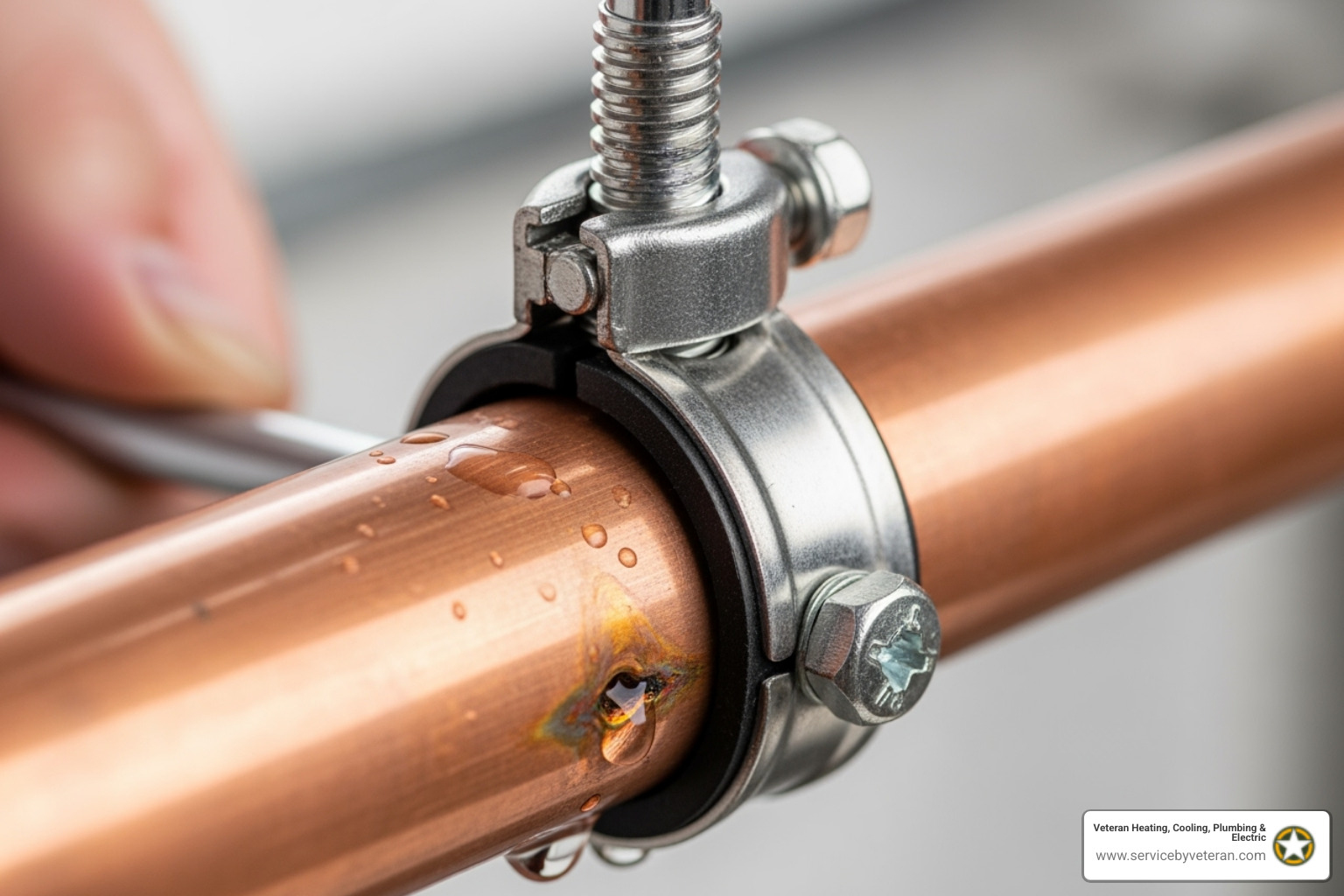
How they work: A metal sleeve with a rubber gasket fits over the leak. Tightening the bolts compresses the gasket against the pipe, creating a watertight seal.
These clamps are ideal for pinhole leaks and small cracks in metal (copper, galvanized) and plastic (PVC, CPVC) pipes. The only tools needed are a screwdriver or wrench.
Epoxy Putty: A Moldable Solution for Small Leaks
Epoxy putty is a moldable substance that hardens to form a solid plug.
How it works: Knead the two parts of the putty together to start a chemical reaction. Within minutes, press the putty firmly over the leak, shaping it to the pipe. It bonds to metal, PVC, and most other materials.
This method is excellent for pinhole leaks, small cracks, and leaks at joints where clamps won't fit. Curing time is typically 30-60 minutes. Surface preparation is critical: the pipe must be clean and completely dry for the putty to adhere properly. Lightly sanding the area can improve the bond.
Self-Fusing Silicone Tape: The Stretch-and-Wrap Fix
This innovative tape fuses to itself, not the pipe, creating a compression seal.
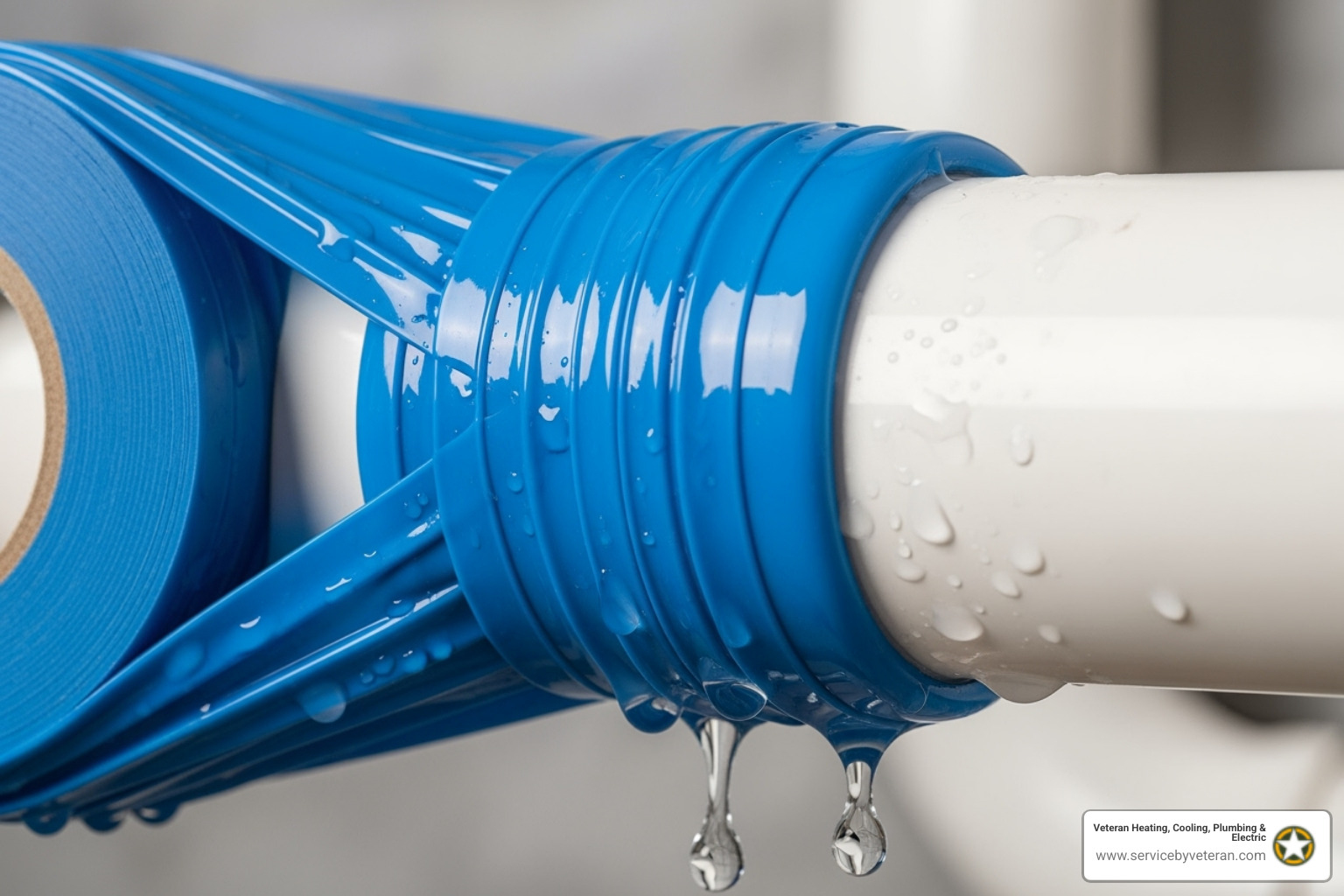
How it works: The tape has no adhesive. When stretched and wrapped over itself, it bonds to create a seamless, waterproof layer. It works even on wet or dirty surfaces.
This tape is best for low-pressure lines and quick fixes on all pipe types. Quality tapes have high temperature ratings (up to 500°F) and can handle significant pressure ratings. For the application technique, stretch the tape tightly and wrap it around the leak, overlapping each pass by at least 50%. The more you stretch and overlap, the stronger the seal.
Pipe Wraps & Repair Kits: For More Serious Damage
For larger cracks or compromised pipes, a full pipe repair kit provides a more robust solution.
What's in a kit: Most kits include an epoxy stick and a fiberglass-reinforced tape soaked in water-activated resin.
How it works: First, apply the epoxy to plug the leak. Then, dip the resin tape in water to activate it and wrap it tightly around the damaged area, covering the epoxy. The resin cures into a hard shell, providing structural support.
These kits are best for larger cracks and work on a wide range of materials, including metal, plastic, fiberglass, and concrete. The curing process is fast, often hardening in 30 minutes, which is ideal when you need to restore water service quickly. For in-depth, industry-recognized guidance on composite wraps and repair methods, see the PRCI Pipeline Repair Manual.
Even the best temporary fix is still temporary. These products are a bridge to a permanent, professional solution.
When DIY Isn't Enough: Calling a Professional Plumber
Temporary fixes are crucial in an emergency, but they are not permanent solutions. Relying on a patch for too long can lead to more significant problems. Knowing when to call a professional is the smartest, safest, and most economical choice.
Signs You Need a Pro
Call for professional pipe repair in these situations:
- Major pipe bursts: If water is gushing, no temporary fix will suffice. This requires immediate professional intervention to replace the damaged pipe section.
- Hidden leaks: Water stains on ceilings, unexplained high water bills, or the sound of running water indicate a leak you can't see. Professionals use diagnostic equipment to find these leaks without unnecessary demolition.
- Recurring problems: If you're repeatedly patching the same pipe or new leaks keep appearing, there's likely an underlying issue like high water pressure or widespread corrosion.
- Low water pressure: A sudden drop in pressure throughout your home can signal a major leak in your main water line.
- Sewer odors or slow drains: These symptoms point to drainage system issues that require specialized equipment, as detailed in our Sewer Repair Service guide.
- Old or corroded pipes: If your home has aging pipes, especially galvanized steel, patching is a temporary delay of an inevitable replacement.
Dangers of Failed Repairs
An inadequate repair can lead to costly and dangerous consequences:
- Structural damage: Water seeps into drywall, wood framing, and insulation, causing rot and weakening your home's structure.
- Mold growth: Mold can begin growing in damp areas within 24-48 hours, posing health risks and requiring expensive remediation.
- Increased water bills: Even a slow drip wastes hundreds of gallons, costing you far more than a proper repair.
- Catastrophic failure: A temporary patch can fail without warning, causing a flood that destroys flooring, furniture, and personal belongings.
Long-Term Solutions and Preventative Measures
A professional plumber provides lasting solutions, not just quick fixes.
- Pipe replacement: For old or corroded systems, replacing a section or repiping the house is often the most cost-effective long-term solution, ensuring reliability and better water quality. We provide a lifetime warranty on parts and labor for this work.
- Trenchless repair methods: For underground lines, we use modern techniques like Cured-In-Place Pipe (CIPP) lining to repair pipes with minimal digging, saving your landscape and driveway.
- Preventative maintenance: Regular inspections can catch problems early. We check for corrosion, test water pressure, and ensure pipes in vulnerable areas are properly insulated to prevent frozen pipes in winter.
Proper maintenance prevents emergencies. We provide honest assessments and effective solutions to protect your home.
Frequently Asked Questions about Pipe Repair
Here are answers to common questions homeowners have about leaky pipes.
How can I tell if my temporary pipe repair was successful?
After applying a temporary pipe repair and turning the water back on, check for success:
- Wipe the area completely dry.
- Press a dry paper towel against the repair. If it stays dry after a few minutes, the initial seal is good.
- Check the patch. It should feel firm and secure, not loose.
- Monitor the repair for several hours. A successful fix will show no new drips, beads of water, or moisture at the edges of the patch. Any sign of wetness means the seal is not holding.
What is the best way to clean up after a pipe leak?
Proper cleanup is essential to prevent mold and further damage.
- Remove standing water immediately with towels, a mop, or a wet/dry vacuum.
- Empty the affected area, moving furniture and other items away from the wet zone.
- Disinfect all hard surfaces that got wet with a solution of one ounce of bleach in four gallons of hot water (use gloves and ensure ventilation).
- Dry the area thoroughly. Use fans and a dehumidifier to circulate air for at least 24 hours.
- Inspect for material damage. Waterlogged particle board, common in cabinets, will swell or feel soft and likely needs replacement.
Are there specific pipe repair methods for different pipe materials?
Yes, compatibility between the repair method and pipe material is crucial.
- Copper pipes: Pipe clamps and epoxy putty are effective temporary fixes. Permanent repairs traditionally involve soldering, though modern press fittings are also used.
- PVC and CPVC pipes: Most temporary methods work well on these plastic pipes. Permanent repairs use a special solvent cement (different types for PVC and CPVC).
- PEX pipes: These flexible tubes rarely leak along their length. Leaks almost always occur at fittings due to improper installation. The fix requires cutting out the bad connection and installing a new fitting with specialized crimping tools.
- Galvanized steel pipes: These older pipes corrode from the inside out. While a clamp or epoxy might offer a very short-term patch, the entire pipe system is often compromised. Replacement is almost always the recommended permanent solution. For issues related to old, clogged pipes, our Drain Cleaning Arvada services can provide more insight.
Conclusion
Knowing how to apply a temporary pipe repair—whether with a clamp, putty, or tape—can prevent a small leak from becoming a disaster. These DIY solutions are excellent for controlling a situation and buying you time.
However, it's critical to remember that DIY repairs are not permanent. They are a bandage, not a cure. Leaving a temporary fix in place is a gamble that can lead to catastrophic failure, water damage, and mold growth, often resulting in costs far exceeding a professional repair.
At Veteran Heating, Cooling, Plumbing & Electric, we solve plumbing problems for good. Our experienced team uses specialized tools and permanent solutions to address the root cause of the leak, giving you long-term peace of mind. As a veteran-led, locally owned company, we do things right the first time.
We stand behind our work with a lifetime warranty on parts and labor and a money-back guarantee. Use a temporary fix to stop the immediate damage, but then call us for a lasting solution. For a permanent solution to your plumbing problems, view Our Services. We're here to stop the drip for good.

